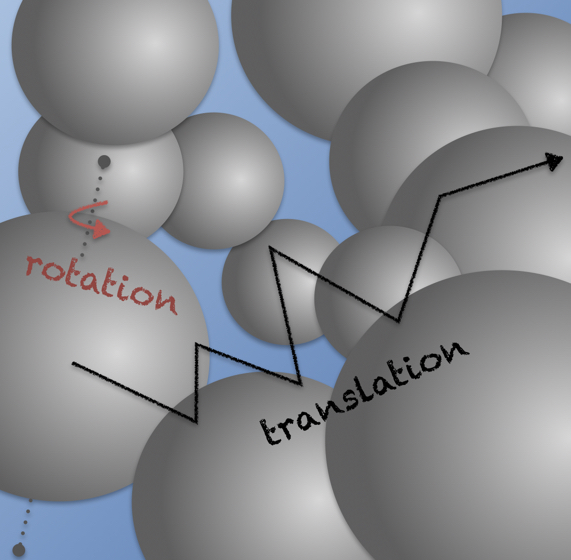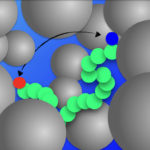Self-crowding of globular proteins
 Molecular motion of biopolymers in vivo is known to be strongly influenced by the high concentration of organic matter inside cells, usually referred to as crowding conditions. We studied three proteins, αB-crystalline, bovine serum albumin, and hen egg-white lysozyme in aqueous solution. SAXS was used to study the interactions between the proteins in solution, whereby it is shown that the three cases cover the range between a weakly interacting hard-sphere system and screened Coulomb repulsion combined with short-range attraction. Our results demonstrate that long-time translational diffusion quantitatively follows the expected increase of macro-viscosity upon increasing the protein concentration in all cases, while rotational diffusion experiments reveals protein-specific behavior spanning the full range between the limiting cases of full decoupling from (αBc) and full coupling to (HEWL) the macro-viscosity.
Molecular motion of biopolymers in vivo is known to be strongly influenced by the high concentration of organic matter inside cells, usually referred to as crowding conditions. We studied three proteins, αB-crystalline, bovine serum albumin, and hen egg-white lysozyme in aqueous solution. SAXS was used to study the interactions between the proteins in solution, whereby it is shown that the three cases cover the range between a weakly interacting hard-sphere system and screened Coulomb repulsion combined with short-range attraction. Our results demonstrate that long-time translational diffusion quantitatively follows the expected increase of macro-viscosity upon increasing the protein concentration in all cases, while rotational diffusion experiments reveals protein-specific behavior spanning the full range between the limiting cases of full decoupling from (αBc) and full coupling to (HEWL) the macro-viscosity.
Roos M, Ott M, Hofmann M, Link S, Rössler E, Balbach J, Krushelnitsky A, and K. Saalwächter. Coupling and Decoupling of Rotational and Translational Diffusion of Proteins under Crowding Conditions. J. Am. Chem. Soc. 138,10365–10372 (2016)
Roos M, Hofmann M, Link S, Ott M, Balbach J, Rössler E, Saalwächter K, Krushelnitsky A. The “long tail” of the protein tumbling correlation function: observation by 1H NMR relaxometry in a wide frequency and concentration range. J. Biomol. NMR 4, 403-415 (2015)
Funding was provided by the DFG, SFB-Transregio 102, projects A08 and B12
Effects of Confinement on Structure and Dynamics of IDPs
 Between 5 to 40% of the cellular volume is occupied by macromolecules, a phenomenon known as macromolecular crowding. Due to the extended hydrodynamic dimensions and conformational flexibility of IDPs, is has been predicted that crowded environments strongly affect the conformational space of IPDs. While some experiments revealed indeed the pronounced formation of secondary structures under crowding conditions, other experiments displayed unexpectedly small effects on the conformational dimensions. We want to characterize the impact of crowding on the structure and diffusional dynamics of IDPs using polymer crowders and globular proteins of various sizes and interaction potentials. The aim is to compare the properties of different IDPs in order to investigate the underlying mechanism. The main methods are single-molecule fluorescence spectroscopy and X-ray scattering experiments.
Between 5 to 40% of the cellular volume is occupied by macromolecules, a phenomenon known as macromolecular crowding. Due to the extended hydrodynamic dimensions and conformational flexibility of IDPs, is has been predicted that crowded environments strongly affect the conformational space of IPDs. While some experiments revealed indeed the pronounced formation of secondary structures under crowding conditions, other experiments displayed unexpectedly small effects on the conformational dimensions. We want to characterize the impact of crowding on the structure and diffusional dynamics of IDPs using polymer crowders and globular proteins of various sizes and interaction potentials. The aim is to compare the properties of different IDPs in order to investigate the underlying mechanism. The main methods are single-molecule fluorescence spectroscopy and X-ray scattering experiments.
Project is funded by the DFG, GRK 2467

